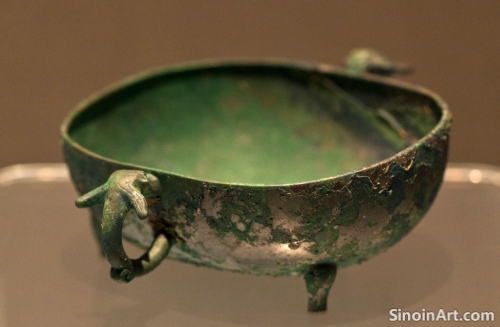The Significance of Jade Inlays on Bronze: Combining Materials and Symbolic Meanings
|
The integration of jade inlays into Chinese bronze ware was a deliberate and powerful artistic choice, highlighting the symbolic importance of both materials and their combined impact. The combination of these materials served both artistic and symbolic purposes, and helped to enhance the status and spiritual power of the resulting works. The fusion of different materials helped to create some of the most beautiful pieces of ancient Chinese art.  Jade, with its smooth texture, rich color, and perceived spiritual properties, was highly valued in ancient China, representing virtue, purity, and immortality. The addition of jade to bronze objects enhanced their symbolic potency and highlighted their connection to the spiritual realm. The careful blending of these materials was not an accident, but rather a conscious and considered artistic decision.  The careful selection and shaping of jade inlays, combined with their precise placement on bronze objects, highlights the technical and artistic skill of the ancient craftsmen. The crafting of these objects required a high degree of expertise in both metalworking and also in the shaping of stone. The ability to work with both jade and bronze reveals a high level of both artistic and technical skill.  The interplay of jade and bronze created a visual and symbolic dialogue between the two materials, with the warm hues of bronze and the cool tones of jade complementing each other. The contrast between the two materials helps to highlight both their differences and also their complementary qualities. The combination of these materials helps to add both depth and a heightened symbolic power. The study of jade inlays on bronze artifacts reveals the complex interaction between different materials, and the symbolism that is associated with them. These objects help to reveal the depth and breadth of ancient Chinese artistic understanding. The combination of these materials helps to further connect us with the world of the past. |
Tag : bronze jade inlay, Chinese materials, ancient symbolism, decorative arts, composite objects
Related information
- The Influence of Zhou Dynasty Ritual Bronzes on Later Chinese Art and Culture
- The Use of Bronze in Ancient Chinese Astronomical Instruments: Innovation and Precision
- The Role of Bronze in Ancient Chinese Warfare: Strategies and Weapons
- Bronze Ware and Trade Networks in Ancient China: Exchange and Interaction
- The Influence of Ancient Chinese Bronze Ware on Later Japanese Art and Design
This article explores the lasting influence of Zhou Dynasty ritual bronzes on later Chinese art and culture, highlighting their impact on forms, designs, the importance of inscriptions, and the continued relevance of ritual and ancestral veneration.
This article explores the use of bronze in ancient Chinese astronomical instruments, highlighting its role in creating armillary spheres, sundials, and other tools used for observation and measurement, and demonstrating the ingenuity and precision of ancient Chinese scientific thought.
This article explores the role of bronze in ancient Chinese warfare, highlighting the types of weapons, armor, and chariot fittings, and examining the strategies and tactics employed, revealing the military power of the era.
This article explores the role of bronze ware in ancient Chinese trade networks, highlighting its importance as a trade commodity, its contribution to the exchange of cultural ideas, and its role in connecting different regions of China.
This article explores the influence of ancient Chinese bronze ware on later Japanese art and design, highlighting the adoption of Chinese forms and techniques, the development of unique Japanese styles, and the impact of cultural exchange on creative expression.